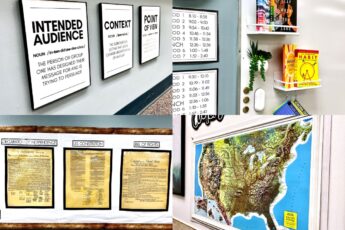Learning the 50 states and all 5 of the Great Lakes is a rite of passage for any American elementary student, and usually any middle school student, too. But then something strange happens—it becomes assumed that by high school, students simply know them all and the 9-12 standards skip right over this basic, yet crucial information.
Unfortunately, if you teach high school U.S. History you know all too well that on the day you are covering the three colonial regions or the Dust Bowl you better have a map ready. We know visuals are a given to enriching any direct instruction, but it’s also because we know most of our students can’t recall these basic aspects of U.S. geography. It is in these moments that it’s most apparent something is missing in the curriculum.
However, it’s already tough to cover all the required content, plus all the skills, so finding time for this sort of “review” can be seemingly impossible.
This exact problem really chewed at me the first few years of teaching U.S. History for two reasons. One, if my students generally didn’t know something then I felt it wasn’t beneath me to help them learn it. And two, as with anything, whether it’s a foreign language or long division or the 50 state capitals, if the brain isn’t constantly required to know it, it will forget it.
So it really isn’t our students’ fault, and we should be meeting students where they are. As teachers, it’s our job to lift them up!
Now this all rests on a third aspect that I kept coming back to as well: basic geography is something I feel is fundamental to know. Fundamentals are always worth finding at least a little bit of dedicated class time to teaching.
So, one summer, I began searching for how to effectively and efficiently prepare my students so they would walk out of my classroom door for the last time knowing what I deeply felt was essential content. Yes, it was rote memorization-type information, but it was the hook on which so much common knowledge is hung.
I followed a few science-backed principles that year with much success and geography has been a key component of my U.S. History course ever since. The best part is the minimal class time it took!
Using brain science to guide your implementation, you too can have success in teaching geography basics in only a handful of class periods by following these 5 basic principles.
Plus, scroll to the very bottom get your own print-and-go kit that requires essentially zero prep time. Really! Or, click the button below to head straight there!
1. Decide the essential learning
In this case, “essential” really means relevant and meaningful which we know is the key to lasting learning. Right away, I knew learning state capitals wasn’t absolutely crucial for my curriculum. It is New Orleans that comes up multiple times, not Baton Rouge.
So I have my students learn each state’s largest (or most popular) city, rather than its capital city. Sorry, Baton Rouge. And, most importantly, I explain this “why” to my students:
– Larger cities, which, yes, are sometimes state capitals, will come up throughout the year, like Chicago’s meat packing district, New York City’s Ellis Island, and the Little Rock Nine.
– Current news events will more likely be happening in those large cities or discussed in relation to them. (“Two hours north of Los Angeles”)
– Cultural references, and professional sports especially, are tied to those cities and their history. Chicago Bulls, anyone?
– Lastly, and most simply, I hope my students never make a fool of themselves because they didn’t know there is a Kansas City in Missouri.
In addition to selecting 50 cities I felt were essential, I also selected the 50 most essential physical features in the United States.

Decide what the essential geographic information is for your students and be okay with the rest being not as essential.
2. Have students own their learning (outside of class time)
Beyond providing a list of the 50 states and cities and 50 geographic features, and blank maps, leave your students responsible for learning where they are located (and how to spell them!).
Encourage them to seek out apps or online games or create their own. Every year, without much more than a nudge from me, at least one student will create a Quizlet game, the rest will play it, and it will become the hottest new game at school. I’m shocked every year the competitiveness that comes out of my students all trying to get the fastest time.
There are several other ways to encourage students to take ownership of their learning outside of the classroom. We Are Teachers has a great blog post with some additional ideas.
3. Show them the “Forgetting Curve”

Psychologist Hermann Ebbinghaus’ findings are all the scientific proof you need to counter your students’ undying belief that they study better when they cram. Thankfully, this perennial myth can be explained in a simple graph. I even show his forgetting curve graph over and over to students throughout the year because once doesn’t seem to be enough. See what I’m doing there? 😉
In short, the human brain will remember new information with 100% accuracy for a very brief time—mere minutes—and then quickly forget most of it. After two days, the recall rate is down close to 20%.
This is why your teenagers don’t remember where all 50 states are located even if they did know them in 5thgrade and again in 8thgrade. But that doesn’t mean it’s fruitless to revisit it again. In fact, Ebbinghaus proved that is exactly what they should be doing!
Revisiting previously learned information a couple of days, a couple of weeks, a couple of months, or even a couple of years later significantly raises the “bottoming out” from 20% to 60, 70, or 80% and eventually it stays at 100%.
Show your students his curve. Post it on your wall. Point to it over and over again. Eventually they will become believers too in this not-so-radical approach.
4. Spread out the studying
The Forgetting Curve is the exact reason, then, you should follow the method of “spaced repetition.”
Some information is just simply the kind made for memorization, like how to spell Massachusetts and locate it on a map. (My West Coast students complain about this one every year!) Even after making the information meaningful and finding an engaging way to learn it, it is still data that needs to be committed to memory. And that can be hard because learning is work.
Therefore, don’t do a quick geography unit in the fall thinking it will lay the foundation for the rest of the year.
Instead, use that same number of days differently. Introduce the essential content at the beginning, yes, but revisit it throughout the year by having a few assessments spaced throughout.
I have found two quizzes and a final test, spaced about 6 weeks apart, works well for our 18-week semesters. First semester we cover political features and second semester we focus on physical features.
5. Make constant references
And, lastly, the best part about continually having something going on in the background is that you have it in your teacher back pocket at all times. For example:
Have 10 minutes between class starting and the planned fire drill alarm going off? “Okay kids, who thinks they can locate all 50 cities without even a glance at their study map?”
Teaching about the Louisiana Purchase today? “First table group with Louisiana spelled correctly on top of all group members’ Cornell notes….”
Stuck on a creating a purposeful bell ringer one day? “We have a geography quiz next week! Take out your planner and schedule five times in the next eight days you will study for 20 minutes.”
Again, constant “spaced repetition” is their friend. Let it go two or three weeks without any mention, on purpose. Then just kick-start their memory out of nowhere. That is where the deep remembering will begin to happen.
Overall, I have been impressed with how well these strategies not only encourage my students to find interest in learning memorization-type information, but also be successful in it!
Click below to grab your own own print-and-go U.S. Geography kit!

Save time and download a complete 4-part test kit that includes a study map, two quizzes, and a final test (plus answer keys and differentiation tools).
Just pick the option that best fits your classroom needs: 50 states and 50 largest cities, 50 important water and landmark features, or bundle them together and save big!
Feature image photo credit: Rawpixel.com







